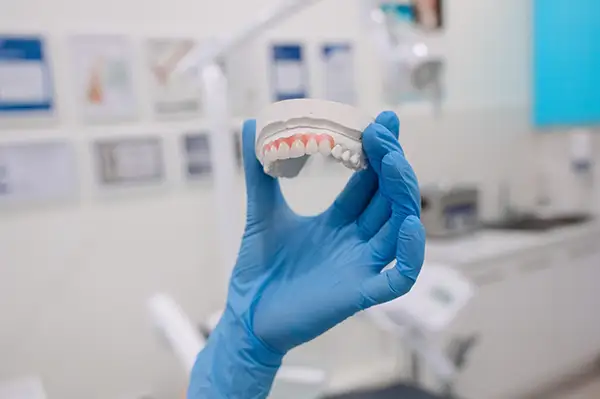Grins & Giggles Family Dentistry is now accepting new patients! |
Restorative Dentistry Spokane Valley, WA
Our team at Grins & Giggles Family Dentistry in Spokane Valley is committed to preserving your oral health through comprehensive preventive care. We know excellent dental hygiene and regular checkups are the foundation of a healthy smile. Still, factors like genetics, aging, accidents, or lapses in oral hygiene can lead to dental issues. When problems arise, our skilled restorative dentistry team works to restore your teeth's natural function, structure, and appearance. Our treatments are customized to your needs, helping you regain confidence and maintain optimal oral health. Comprehensive Restorative Dental ServicesOur dentist offers several restorative dental services for all of your needs. These include: Dental ImplantsDental implants in Spokane Valley are the preferred tooth replacement option for many of our patients. This treatment replaces both the tooth root and crown, offering outstanding stability and longevity. A titanium post is surgically placed into the jawbone, where it bonds through the process of osseointegration, creating a strong foundation like a natural root. Once healed, a custom crown is attached to the implant, restoring the tooth's appearance and function. Dental implants preserve jawbone density, avoid impacting adjacent teeth, and allow you to enjoy your favorite foods without worry. Beyond functionality, dental implants help maintain your facial structure by preventing bone loss that typically occurs with missing teeth, keeping your smile youthful and natural-looking. Dental BridgesMissing teeth affect chewing, speech, and facial structure. Traditional dental bridges replace one or more consecutive teeth without removable devices. Bridges consist of pontics - artificial teeth that are anchored by crowns on neighboring healthy teeth. These create a stable, natural-feeling restoration. Implant-supported bridges offer an alternative for those wanting to avoid altering healthy teeth, especially when replacing multiple teeth. Our careful planning ensures proper fit and function while supporting your oral health. With proper care, dental bridges can last for many years, helping you avoid the complications that come with gaps, such as shifting teeth or bite misalignment. DenturesFor patients in Spokane Valley that are missing multiple teeth, dentures provide an effective solution. Modern dentures look natural and feel more comfortable than ever. Complete dentures replace all teeth in an arch and rest on the gums, customized to your facial structure and preferences. Partial dentures fill gaps while using remaining teeth for support, preventing shifting and bite problems. Creating dentures requires multiple appointments for impressions, measurements, and fittings to ensure comfort and proper jaw alignment. For improved stability, implant-supported dentures secure your prosthetics to implants, reducing slipping and improving chewing and speech. This technology allows denture wearers to enjoy an enhanced quality of life without the common frustrations of traditional dentures. We guide you through proper denture care, including cleaning, storage, and maintenance. With good care, dentures can serve you well for many years, restoring your ability to eat comfortably and speak clearly while boosting your confidence. Dental CrownsDental crowns in Spokane Valley fully cover teeth damaged by decay, trauma, or wear, restoring shape, size, and appearance. Using digital impressions or molds, we create custom crowns from high-quality materials like porcelain, ceramic, or porcelain-fused-to-metal. Typically, crown placement involves two visits: preparation and temporary crown placement, followed by fitting and cementing the permanent crown. Crowns can last for decades with proper care, maintaining a natural look. They also protect weakened teeth from further damage, reducing the risk of fractures or additional decay. Tooth ExtractionWhile we aim to save natural teeth, some require extraction to protect your oral health. We perform routine extractions for erupted teeth and surgical extractions for impacted or severely damaged teeth. We use modern techniques and anesthesia to ensure comfort. Post-operative instructions and follow-up care help promote healing. We also discuss tooth replacement options to maintain your oral function and smile. Timely extractions can prevent the spread of infection and alleviate pain, supporting your overall health. Wisdom Teeth RemovalWisdom teeth often cause problems due to limited jaw space, leading to impaction, misalignment, or crowding. Removing problematic wisdom teeth early can prevent complications such as infection, cyst formation, or damage to adjacent teeth. Our surgical team uses advanced imaging and techniques to plan safe, efficient extractions, often completed in one appointment with thorough post-operative care guidance. We prioritize patient comfort and recovery throughout the process. Root CanalWhen infection reaches a tooth's pulp, root canal therapy removes infected tissue, cleans and disinfects the canals, and seals them to save the tooth and eliminate pain. A crown usually follows root canal treatment to protect the tooth, ensuring years of functional use while preserving your natural smile. This approach avoids extraction and the need for more extensive restorative work. Dental FillingsTooth decay is common but treatable with modern composite resin fillings that blend with your natural tooth color. These fillings bond directly to tooth structure, requiring less removal of healthy enamel and offering durable, discreet repairs. Placed in a single visit, composite fillings restore your tooth's function and appearance while preserving its health. Our conservative approach supports the longevity of your teeth by maintaining as much natural structure as possible. Inlays & OnlaysWhen damage exceeds what fillings can repair but doesn't require a full crown, inlays and onlays provide a strong, conservative solution. Inlays fit within the tooth's chewing surface; onlays cover one or more cusps. Custom-made in a dental lab to match tooth color and translucency, these restorations require two visits: preparation and impression, then bonding. They preserve more natural tooth than crowns while providing lasting strength and protection against further decay or damage. Begin Your Restorative JourneyIf you are experiencing dental discomfort or have concerns about your oral health, our restorative dentistry team in Spokane Valley is ready to help. We do so with compassionate care to restore your smile and improve your quality of life. Contact us today at (509) 928-4746 to schedule a consultation and discover the benefits of restorative dentistry. |
|
|